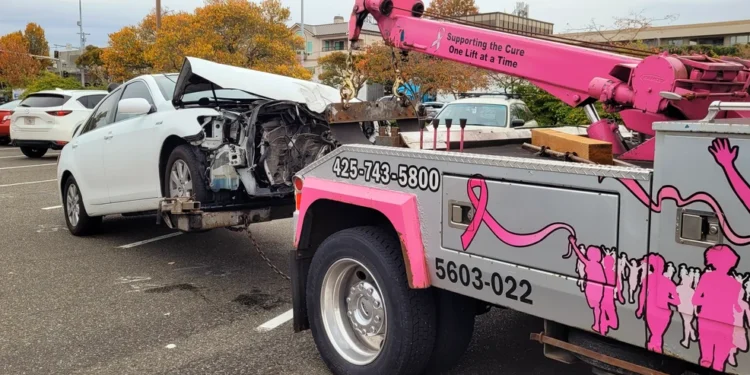The Edmonds-Kingston ferry route was suspended until further notice after a car and a train crashed near the Edmonds Ferry Terminal on Tuesday afternoon. The scene has since cleared.
The crash happened shortly before noon at the railroad crossing on Main Street. Both Main Street and Dayton were fully blocked, according to Edmonds police.
Those involved in the crash have minor injuries.
Both roads reopened around 1:14 p.m., allowing the Edmonds ferry to resume service.
The Edmonds-Kingston ferry suspension demonstrates how car-train crashes at grade crossings near terminals create cascading transportation disruptions, with blocked roads preventing ferry passengers from reaching vessels and forcing route closures affecting thousands of commuters.
The shortly before noon timing places the crash during midday when ferry traffic typically experiences lulls between morning and evening rush periods, potentially reducing the passenger impact compared to peak commute hours when route suspensions strand hundreds.
The Main Street railroad crossing location near the Edmonds Ferry Terminal creates inherent conflict where vehicular ferry access intersects with BNSF Railway freight and Amtrak passenger trains serving the Seattle-Vancouver corridor, a known safety concern.
The Main Street and Dayton full blockage indicates the crash scene required extensive area closure for emergency response, investigation, and cleanup, with the dual road closures eliminating alternative routes to the ferry terminal.
The minor injuries outcome represents fortunate result given train-vehicle collisions’ typical severity, with the characterization suggesting occupants avoided the fatal or serious trauma that grade crossing accidents frequently produce.
The 1:14 p.m. reopening timing indicates approximately 75-minute closure duration from the shortly-before-noon crash, with the relatively quick clearance suggesting either minimal train damage allowing track restoration or efficient coordination between police, railway, and ferry officials.
The ferry service resumption following road reopening reflects Washington State Ferries’ dependency on vehicular access, with the route suspension necessary because passengers and vehicles cannot board without functioning terminal approaches.
The Edmonds police role coordinating road closures and investigation demonstrates local law enforcement’s responsibility for grade crossing accidents within city limits, though federal railroad regulations and BNSF Railway participation complicate jurisdictional issues.
The car-train crash at a railroad crossing raises questions about whether crossing arms malfunctioned, drivers attempted to beat approaching trains, or visibility issues prevented motorists from seeing trains in time to stop.
The Main Street crossing’s proximity to the ferry terminal creates unique hazard where drivers rushing to catch departing ferries may take risks at grade crossings, prioritizing vessel boarding over safe railroad crossing practices.
The Edmonds-Kingston route importance as primary Kitsap Peninsula connection means suspensions affect commuters traveling between the Olympic Peninsula and Seattle metropolitan area, with alternative routes requiring lengthy drives through Tacoma.
The Tuesday afternoon occurrence during a weekday suggests the crash affected both leisure travelers and essential workers, though midday timing reduced impact on peak-period commuters whose delays would create larger economic disruptions.
The minor injury characterization without specificity about the number of vehicle occupants or injury types leaves uncertainty about whether one person or multiple individuals required medical attention and whether they were transported to hospitals.
The railroad crossing safety record at this specific Main Street location remains unaddressed, with the incident potentially representing isolated accident or latest in a series of crashes indicating needed infrastructure improvements like grade separation.
The BNSF Railway involvement through its track ownership means the freight railroad company participated in scene investigation and clearance, with federal regulations requiring thorough documentation before trains resume normal operations through accident sites.
The Amtrak Cascades service potential disruption if passenger trains were delayed by the crossing incident creates ripple effects beyond local ferry passengers, affecting travelers throughout the Seattle-Portland-Vancouver corridor served by the intercity rail route.
The Washington State Ferries communication with stranded passengers through social media, terminal announcements, and website updates presumably informed travelers about the suspension cause and expected resumption timing, though the story doesn’t detail notification methods.
The Edmonds community impact extends beyond transportation with Main Street closure affecting downtown businesses during lunch hours, potentially reducing customer access and sales for restaurants and shops dependent on ferry passenger traffic.
The relatively brief disruption compared to major incidents lasting hours or days demonstrates efficient emergency response coordination, with Edmonds police, fire, railway officials, and ferry personnel apparently working cohesively to restore normal operations.
Seattle-area commuters’ increasing frustration with ferry reliability challenges receives another data point, with even brief suspensions like this crash-induced closure contributing to perceptions that Washington State Ferries cannot maintain consistent service.







